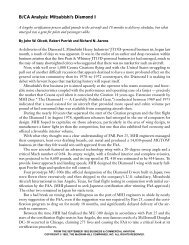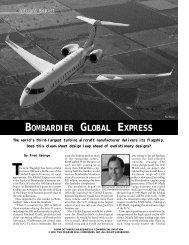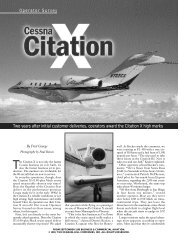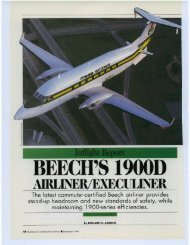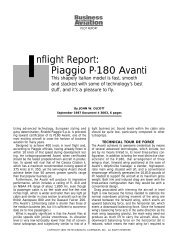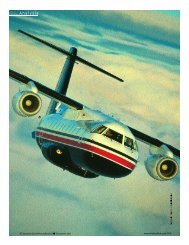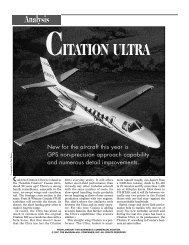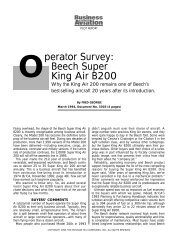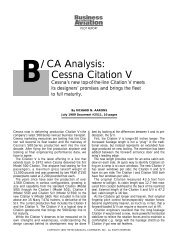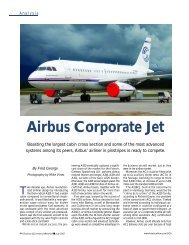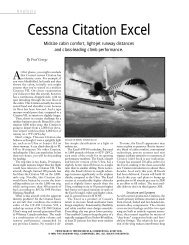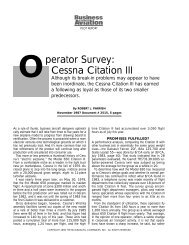December 1993/Citation V ultra
December 1993/Citation V ultra
December 1993/Citation V ultra
Create successful ePaper yourself
Turn your PDF publications into a flip-book with our unique Google optimized e-Paper software.
PILOT REPORT<br />
U<br />
pdate:<br />
<strong>Citation</strong> V Ultra<br />
Cessna’s popular eight-place light business<br />
jet gets a thrust boost, new Honeywell<br />
avionics and more payload capacity.<br />
By FRED GEORGE<br />
<strong>December</strong> <strong>1993</strong>, Document No. 2500 (5 pages)<br />
Cessna again is turning up the heat in the highly competitive,<br />
light business jet market. In September 1994,<br />
the world’s most prolific manufacturer of turbine business<br />
airplanes will start delivering the new <strong>Citation</strong> V<br />
Ultra, the ultimate straight-wing <strong>Citation</strong>.<br />
The V Ultra, slated for certification in March 1994,<br />
will have better overall performance, a higher level of<br />
standard equipment and a new avionics suite that<br />
includes three large-format displays and an upgraded<br />
flight management system. Performance improvement<br />
is entirely the result of installing more powerful turbofan<br />
engines.<br />
Aerodynamically, the airframe is virtually identical to<br />
the <strong>Citation</strong> V. The V Ultra will be fitted with 3,045<br />
pounds-thrust Pratt & Whitney of Canada JT15D-5D<br />
engines, the most powerful version of the small turbofan<br />
engine family that made its debut more than two<br />
decades ago.<br />
The -5D engines, internally changed and upgraded,<br />
will have five percent more thrust than the -5A turbofans<br />
installed on the <strong>Citation</strong> V, and they will give up nothing<br />
in flat-rating. They will produce rated takeoff thrust<br />
up to 80°F at sea level, and they also will squeeze<br />
about one percent more thrust out of a pound of jet fuel<br />
at altitude. (See sidebar.)<br />
Extra thrust will enable the V Ultra to out-climb and<br />
generally out-perform the current <strong>Citation</strong> V. For example,<br />
Cessna claims the V Ultra will be able to climb to<br />
FL 430 in 29 minutes—10 minutes quicker than a <strong>Citation</strong><br />
V. Less than half an hour later, the Ultra will be<br />
able to step-climb to FL 450.<br />
Cessna estimates that cruise speeds will increase by<br />
three to five knots as well.<br />
Most airframe systems are essentially unchanged<br />
from the <strong>Citation</strong> V, although the long list of standard<br />
equipment items will increase the basic operating<br />
weight by 260 pounds. Cessna marketing officials<br />
point out that the longer standard equipment list<br />
accounts for most of that weight increase. The new<br />
aircraft’s maximum gross takeoff weight (MGTOW)<br />
will be bumped up by 400 pounds to 16,300<br />
pounds, so the V Ultra will actually have an additional<br />
300-plus pounds of payload capacity versus a comparably<br />
equipped <strong>Citation</strong> V. The new aircraft’s payload<br />
with full fuel will be 1,000 pounds, compared to 655<br />
pounds for the <strong>Citation</strong> V.<br />
The V Ultra’s sea-level, standard-day balanced field<br />
length (BFL) should be 3,210 feet at MGTOW—or just<br />
over a plane-length more than the <strong>Citation</strong> V’s. The<br />
initial climb rate of the Ultra, however, is 4,100 fpm,<br />
a 10 percent improvement compared to the <strong>Citation</strong><br />
V’s. The Ultra will have climb performance approaching<br />
but not quite equaling that of the Learjet 35/36.<br />
Under hot and high takeoff conditions, the Ultra<br />
looks even better. The <strong>Citation</strong> V already has hot and<br />
high airport performance that is among the best in its<br />
class, and the Ultra will improve upon those numbers.<br />
For example, Cessna estimates that the V Ultra will<br />
need 4,640 feet of runway for takeoff at 5,000<br />
feet/ISA+20°C, which is 240 feet less than the <strong>Citation</strong><br />
V requires and clearly superior to any other aircraft<br />
in its class. Operators will face few, if any,<br />
COPYRIGHT 1995 THE MCGRAW-HILL COMPANIES, INC. ALL RIGHTS RESERVED
P ilot<br />
Report<br />
range/payload tradeoffs when departing from high<br />
elevation airports on the hottest summer days.<br />
PASSENGER COMFORT<br />
Arguably, the V Ultra will have the most comfortable<br />
cabin Cessna has ever installed in a 500-series <strong>Citation</strong>.<br />
The new aircraft’s cabin is still the longest in the<br />
light jet class at 17 feet and five inches, but it’s about<br />
three inches shorter than the <strong>Citation</strong> V’s. This change<br />
has allowed the cockpit divider bulkhead to be moved<br />
aft by an equal distance for more legroom and storage<br />
space up front for the flightcrew. The forward refreshment<br />
center is somewhat shorter than the one in the<br />
<strong>Citation</strong> V, but Cessna claims it holds an equal volume<br />
of food and beverage supplies.<br />
Mirrors on the bulkhead dividers of the standard interior<br />
will make the cabin appear to be longer. Single<br />
piece, seamless sidewall panels also will add to the<br />
feeling of spaciousness, among other changes.<br />
Plenty of comfort and convenience features will outfit<br />
the cabin: upgraded interior furnishings of wood, fabric<br />
or leather overlays on the sidewall armrests; plated<br />
metal fittings and accordion-pleat window shades in<br />
place of pull-down plastic shades. The standard equipment<br />
list includes a Global Wulfsberg Flitefone VI.<br />
The cabin will seat up to eight passengers in doubleclub<br />
configuration, or seven in the more typical configuration<br />
that will feature a left-side, forward refreshment<br />
center installed ahead of the cabin door.<br />
Passenger chairs have been re-designed with softer<br />
cushions that Cessna claims are more comfortable and<br />
offer increased headroom. Swiveling up to 30 degrees,<br />
the chairs will have integral, retractable headrests in the<br />
seatbacks and will have storage drawers in the<br />
pedestals. These formerly optional features are standard<br />
on the V Ultra.<br />
STANDARD EQUIPMENT<br />
The V Ultra also has a long list of standard equipment<br />
that was formerly on the options list, and it has a new<br />
avionics suite that includes greater component redundancy.<br />
(See sidebar.)<br />
Most of the V Ultra’s standard features, such as the<br />
interior amenities, were ordered as optional upgrades<br />
by as many as 80 percent or more of the <strong>Citation</strong> V<br />
buyers. Cessna decided to combine such popular features<br />
into a package in order to lower the price.<br />
Vapor-cycle, electrically powered air conditioning is<br />
one of the standard features that was an option on the<br />
<strong>Citation</strong> V. The vapor-cycle air conditioner allows the<br />
cabin to be cooled prior to engine start when the aircraft<br />
is linked to a ground power cart. During ground<br />
operations and flight below 18,000 feet, it also can<br />
be used to supplement the refrigeration from the<br />
bleed-air driven air-cycle machine.<br />
On the V Ultra, the landing lights have been moved<br />
to the outboard wing recognition light group, a change<br />
that surely will please many pilots who want to turn on<br />
every exterior light for maximum visibility in congested<br />
areas, such as Class B Airspace. The modification also<br />
likely will improve the service life of the bulbs.<br />
Many other features of the <strong>Citation</strong> V have been<br />
directly carried over to the Ultra, which should please<br />
potential buyers. For example, external luggage compartments<br />
provide 41 cubic feet of room that will hold<br />
850 pounds of baggage, equipment and business supplies.<br />
The aft section of the cabin may be configured to<br />
hold an additional 600 pounds of luggage. Notably,<br />
the new avionics package did not cause any loss of<br />
external baggage volume.<br />
Cessna elected not to adopt the trailing-link-design<br />
main landing gear used on the <strong>Citation</strong>Jet, among other<br />
models. The Ultra retains the conventional main landing<br />
gear short-travel oleo strut used by the <strong>Citation</strong> V.<br />
With all the similarities between the <strong>Citation</strong> V and<br />
the V Ultra, some people have asked about the availability<br />
of an upgrade package. Sorry, there are just too<br />
many differences between the two aircraft, particularly<br />
in regard to the engines and avionics, to make a retrofit<br />
package a feasible option at this time.<br />
PERFORMANCE VERSUS PACKAGE PRICE<br />
Cessna says that Ultra operators will be able to fill the<br />
tanks, load five passengers and their baggage, and fly<br />
more than 1,700 nm with IFR reserves. A <strong>Citation</strong> V<br />
departing with full fuel was limited to three passengers<br />
plus baggage, or to four modestly sized people whose<br />
combined weight could not exceed 655 pounds.<br />
As shown by the Range/Payload Profile, the Ultra also<br />
will be able to fly more than 1,200 miles with maximum<br />
payload, including eight passengers, which is an increase<br />
of more than 400 miles compared to the <strong>Citation</strong> V.<br />
Such range performance does not move the <strong>Citation</strong><br />
V Ultra to the top of the light jet class, nor does its maximum<br />
cruise speed leave the competition in its wake.<br />
But, the <strong>Citation</strong>’s low takeoff and approach V-speeds<br />
make it one of the most docile-handling turbofan aircraft<br />
ever built.<br />
All in all, it’s the V Ultra’s cabin, however, that distinguishes<br />
it from others in this class of business aircraft.<br />
Simply put, the volume available for passengers is without<br />
equal in the light jet class. Factor in the V Ultra’s<br />
newly upgraded interior furnishings, its more sprightly<br />
performance and its new avionics suite and Cessna is<br />
bound to have a sure winner.<br />
The first 20 aircraft will be priced at $5.395 million.<br />
B/CA<br />
COPYRIGHT 1995 THE MCGRAW-HILL COMPANIES, INC. ALL RIGHTS RESERVED
P ilot<br />
Report<br />
L<br />
arge-Format Displays Dominate the<br />
<strong>Citation</strong> V Ultra’s Panel<br />
“Fewer tubes, more information” will be the design theme for the <strong>Citation</strong> V Ultra’s Primus 1000 avionics<br />
suite that will use the largest format CRT displays yet installed in a light jet aircraft. Three eight-by-seveninch<br />
electronic flight instrument screens—left- and right-side primary flight displays (PFDs) and a multi-function<br />
display (MFD) in the center—dominate the panel.<br />
The displays will replace up to five separate CRTs and eight or more conventional analog instruments. Together<br />
they will provide more information than was available even when the panel was stuffed with the five-tube EFIS<br />
option. Honeywell’s engineers, however, face the challenge of making all of this information useful to crewmembers<br />
without immersing them in a triple-screen sea of clutter.<br />
In early October, we pored over Cessna’s <strong>Citation</strong> V Ultra development aircraft flight deck to check on its<br />
avionics suite progress. We found that Honeywell’s engineers were creating an array of alphanumeric, color,<br />
graphic, symbolic and motion cues with which newly transitioning pilots should quickly become comfortable.<br />
Text, numeric and symbology clutter, for example, will be minimized by presenting such data on a need-toknow<br />
basis, reflecting the current dark screen design philosophy. Among other features, green, yellow and<br />
magenta color cues eliminate confusion as to the source of lateral nav information. A curved arc ver-tical speed<br />
indicator display with a rotating needle catches the pilot’s eye with its movement. Magenta airspeed and altitude<br />
trend vector tapes help spot deviations in desired flight performance.<br />
Honeywell has spent considerable time incorporating hand-eye coordination features. The PFDs have positive<br />
click, baro-set knobs on the faceplates—not on isolated remote panels. The MFD faceplate has both a speed set<br />
knob and an altitude pre-select knob, positioned adjacent to the numeric displays they control. In between the<br />
knobs are five, well-spaced line select keys with on-screen soft labels, used for functions such as electronic checklists<br />
and V-speed selection. The menus associated with the line select keys are one-screen deep, enabling quick<br />
and non-confusing return to the main menu screen.<br />
The Ultra’s Primus 1000 avionics suite uses the now popular hub-and-spoke layout, having dual 1/2-ATR integrated<br />
avionics computers (IAC) that contain EFIS symbol generators, flight directors and a fail-passive autopilot<br />
forming the hubs of the system. Only the pilot’s side IAC will have an active autopilot function.<br />
Other avionics manufacturers will tie into the IAC principally by means of ARINC 429 interface spokes,<br />
although the FMS tunes the short-range nav radios by means of discrete ARINC 429 links. Analog interfaces<br />
mainly are limited to the radio altimeter, attitude and directional gyros and the autopilot servos. The result is a<br />
reduction in wire count and weight, compared with conventional box-to-box electrical connections.<br />
Pulling the access panels out of the Ultra’s nose baggage compartment reveals another feature of the Primus<br />
1000. The entire package occupies considerably less volume than the five-tube EFIS option available in the <strong>Citation</strong><br />
V. Twin sets of compact Collins Pro Line 2 and Pro Line 400 remote comm/nav/pulse radios—including<br />
dual DMEs and non-diversity Mode S transponders—reside in the nose just behind the Primus 650 weather<br />
radar. (Currently, Cessna does not plan to offer Primus II radios as an option).<br />
Other system components consist of entry-level, mechanical, vertical and directional spinning gyros furnished<br />
by Honeywell. Cost considerations prohibited the use of strap-down mechanical or interferometer optical gyro<br />
(IFOG) attitude-heading reference systems. Dual Honeywell micro air data computers each provide altitude<br />
reporting, and they are linked to the IAC to provide single waypoint vertical navigation based on short-range<br />
navaid data.<br />
A Global Wulfsberg GNS-X/ES FMS will make its debut in the <strong>Citation</strong> V Ultra. The new single-box FMS will<br />
contain GPS and Loran-C sensors and feature a color CRT display plus a full alpha keyboard.<br />
The entire package will weigh less than the five-tube EFIS option in the <strong>Citation</strong> V—even though the large display<br />
tubes weigh 25 pounds each and the wiring harness will be contained in HIRF and lightning-hardened<br />
shielding.<br />
The V’s avionics package convincingly proves that digital electronics continues to be the fastest-developing<br />
technology associated with business aircraft.<br />
COPYRIGHT 1995 THE MCGRAW-HILL COMPANIES, INC. ALL RIGHTS RESERVED
Distance (nm)<br />
Specific Range<br />
2,000<br />
1,600<br />
1,200<br />
800<br />
400<br />
0.45<br />
0.40<br />
0.35<br />
0.30<br />
TIME AND FUEL VERSUS DISTANCE<br />
Conditions:<br />
800-lb payload;<br />
NBAA IFR reserves (100-nm<br />
alternate); zero wind; ISA<br />
272 nm<br />
1,216 lbs<br />
657 nm<br />
2,232 lbs<br />
SPECIFIC RANGE<br />
FL 450<br />
FL 430<br />
1,053 nm<br />
3,265 lbs<br />
0<br />
0 1<br />
2<br />
3<br />
4<br />
5<br />
Source: Cessna Aircraft Company<br />
Time (hrs)<br />
All data preliminary<br />
FL 410<br />
High-Speed Cruise<br />
FL 390<br />
1,460 nm<br />
4,319 lbs<br />
FL 370<br />
FL 350<br />
1,645 nm<br />
4,741 lbs<br />
High-Speed Cruise<br />
Conditions:<br />
13,000 lbs;<br />
zero wind; ISA<br />
<strong>Citation</strong> V Ultra<br />
These graphs present preliminary range, fuel<br />
and payload information that reflects the<br />
future capabilities of the <strong>Citation</strong> V Ultra. Do<br />
not use these data for flight planning purposes.<br />
Time and Fuel Versus Distance—This<br />
graph shows the plot of a high-speed cruise<br />
mission. The numbers at the hour lines indicate<br />
the cumulative miles and the fuel burned<br />
for the high-speed cruise profile. While the<br />
intermediate points on these lines are accurate<br />
only for the full trip, they can provide the<br />
user with a rough idea of the time and fuel<br />
required for trips of intermediate length.<br />
Specific Range—The specific range of an<br />
aircraft, a measure of its fuel efficiency, is the<br />
ratio of the nautical miles flown to the<br />
pounds of fuel burned (nm/lb). Higher specific<br />
fuel consumption (nm/lb) numbers indicate<br />
better fuel efficiency. This graph shows SFC<br />
values at seven altitudes for the <strong>Citation</strong> V<br />
Ultra at an intermediate cruise weight of<br />
13,000 pounds.<br />
Range/Payload Profile—This graph is<br />
intended to provide rough simulations of trips<br />
under a variety of payload and airport density<br />
altitude conditions, with the goal of flying<br />
the longest distance at high-speed cruise. The<br />
payload lines—intended for gross evaluation<br />
purposes—are each generated from a half<br />
dozen or more points. Elapsed time and fuel<br />
burns, for an intermediate 1,000-pound payload,<br />
are shown at the top of the chart.<br />
Keeping these limitations in mind, it is possible<br />
to get a “feel” for the airplane’s capability.<br />
0.25<br />
FL 330<br />
0.20<br />
340 360 380 400 420 440 460<br />
Source: Cessna Aircraft Company<br />
Speed (KTAS)<br />
All data preliminary<br />
Balanced Field Length<br />
SL<br />
ISA<br />
5,000 ft<br />
ISA+20°C<br />
Gross<br />
Takeoff<br />
Weight (lbs)<br />
Fuel<br />
Burn<br />
(lbs)<br />
Time<br />
(hrs)<br />
RANGE/PAYLOAD PROFILE<br />
1,216<br />
2,232<br />
1<br />
2<br />
3,265<br />
3<br />
4,319<br />
4<br />
3,215<br />
3,100<br />
4,643<br />
4,473<br />
16,300<br />
16,000<br />
2,760<br />
2,540<br />
2,515<br />
2,495<br />
3,930<br />
3,438<br />
3,000<br />
2,690<br />
15,000<br />
14,000<br />
13,000<br />
12,000<br />
1,980-lb Payload<br />
1,500-lb Payload<br />
1,000-lb Payload<br />
500-lb Payload<br />
Zero Payload<br />
Conditions: NBAA IFR<br />
reserves (100-nm alternate);<br />
zero wind; ISA;<br />
high-speed cruise<br />
11,000<br />
Source: Cessna Aircraft Company<br />
All data preliminary<br />
0<br />
250 500 750 1,000 1,250 1,500 1,750<br />
Range (nm)<br />
COPYRIGHT 1995 THE MCGRAW-HILL COMPANIES, INC. ALL RIGHTS RESERVED
P ilot<br />
Report<br />
Pratt<br />
& Whitney of Canada JT15D-5D<br />
The V Ultra’s performance boost comes from the latest variant of the Pratt & Whitney of Canada JT15D,<br />
a veteran of more than two decades of business aircraft service. The original -1 that powered the <strong>Citation</strong> 500 in<br />
late 1971 had but 2,200 pounds of takeoff thrust, a bypass ratio of 3.3:1 and a steep-thrust lapse rate that limited<br />
the <strong>Citation</strong>’s service ceiling to the low- to mid-30s—except when the aircraft was lightly loaded or on particularly<br />
cool days.<br />
Look closely at the -5D, and you will notice a loose family resemblance to the -1, but that is about the only kinship<br />
to be found. Starting at the front, the newest JT15D uses a wide-chord blade fan with computer-refined aerodynamics<br />
and beefier blades that are more resistant to foreign object damage. The fan rotates inside a new<br />
abradable aluminum and Kevlar fan shroud case that offers tighter tip clearance and better fan blade containment.<br />
The modifications permit the fan redline to be raised from 104 to 106 percent N1.<br />
The fan and the low pressure, axial compressor are machined from solid billets of metal. Pratt & Whitney calls<br />
them integrally bladed rotors (IBRs). These one-piece components may be more precisely balanced than similar<br />
components assembled from many parts, and they weigh less, rendering the -5D engine two pounds lighter than<br />
the -5A. They also leak less air and, therefore, are more aerodynamically efficient.<br />
The high-pressure turbine blades are made of single-crystal alloy, allowing the inter-turbine temperature to be<br />
raised by 20°C. The higher temperature limit and the increased N1 fan speed redline enable the -5D to produce<br />
737 pounds-thrust (uninstalled) at 40,000 feet on a standard day compared with 702 pounds-thrust for the -5A<br />
used on the <strong>Citation</strong> V. The -5D’s thrust-specific fuel consumption (TSFC) at altitude is 0.868 pph/pound-thrust versus<br />
0.876 pph/pound-thrust for the -5A—close to a one percent improvement.<br />
An added benefit of the -5D redesign is increased low cycle fatigue (LCF) life. The IBR fan and low compressor<br />
will have a 30,000-cycle LCF compared to 14,000 cycles for similar dovetail-bladed components on the -5A.<br />
P&WC plans to offer exchange IBR components to replace worn or damaged fan rotors or low compressor rotors<br />
at prices that are competitive with detachable blade components.<br />
Best of all, P&WC expects the-5D to have a mature time between overhaul of 3,500 hours and a hot section<br />
inspection interval of 1,750 hours. Engine certification by Transport Canada and the FAA were scheduled to be<br />
completed at B/CA press time.<br />
COPYRIGHT 1995 THE MCGRAW-HILL COMPANIES, INC. ALL RIGHTS RESERVED



